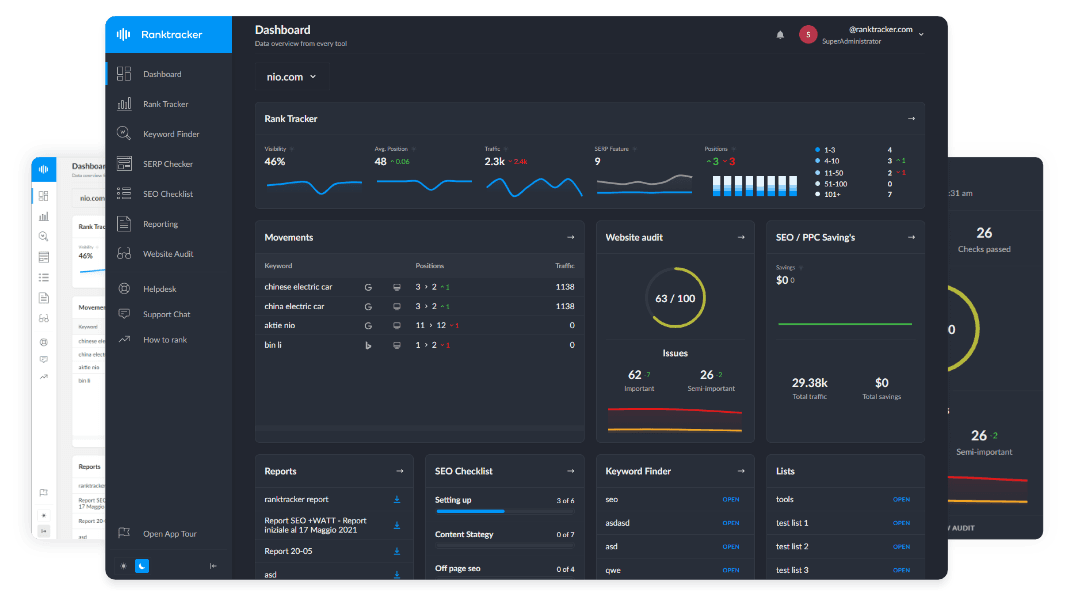Intro
The first thing most people think of when they hear the term "SEO" is keywords. These are the words people type into search engines, and companies include them in website content to improve their rankings. However, keywords aren't everything.
Another thing search engines take into account is search intent. This is simply the reason a user typed those keywords. If they type the name of an object like "hairdryer," for example, the most common reason isn't that they want to buy a hairdryer right now; it's that they want to find out which hairdryer they should buy.
Search engines understand this, so they populate the results page with listicles and product comparison articles. By aligning your website with search intent and adding content that people want to see, you can improve your rankings.
Understanding the Different Types of Search Intent
People use search engines for a variety of different reasons, and these are known as the different types of search intent.
1. Informational Intent
This is when users are seeking information about the keywords they typed. It might be information about a certain person, an event, a business, a concept, or just about anything that exists.
The types of content that satisfy informational intent are:
- Blog posts
- Guides
- Tutorials
- How-tos
- Wikipedia entries
These types of content need to be as clear and readable as possible, making it easy for visitors to pinpoint the information they need and learn from your post.
Because your aim is to encourage people to visit your main landing page, it makes sense to publish informational content about topics that are related to your products or services. You can then mention your offerings or link to other relevant pages on your website to progress the visit through your sales funnel.
2. Navigational Intent
This is when users are looking for a specific page or website they want to visit. While some people will use the autocomplete feature in the address bar to go directly to a website, others will nearly always go through their default search engine.
To make sure your site ranks well for this intent, you need clear branding and easy-to-find key pages. For instance, your About, Contact, and Careers pages should all be as expected, rather than having fancy names or being located somewhere out of the ordinary.
The All-in-One Platform for Effective SEO
Behind every successful business is a strong SEO campaign. But with countless optimization tools and techniques out there to choose from, it can be hard to know where to start. Well, fear no more, cause I've got just the thing to help. Presenting the Ranktracker all-in-one platform for effective SEO
We have finally opened registration to Ranktracker absolutely free!
Create a free accountOr Sign in using your credentials
Make sure users can instantly understand that they're on the right page by using clear and relevant headings and design elements.
3. Transactional Intent
Users have transactional intent when they're ready to make a purchase or take a certain action. Rather than blogs or key web pages, the content you need for this intent includes:
- Product pages
- Service pages
- Sign-up forms
- Pricing pages
To keep users on the product page, you should include all the information they need to comfortably make a purchase. This includes elements such as:
- Trust signals such as security badges, payment methods, customer ratings, and customer reviews
- Prominent CTAs (call-to-action) that clearly show users what to click when they're ready to progress
- Key points about shipping and delivery, such as eligible locations, price ranges, methods, and time estimates
- A streamlined checkout or conversion process that doesn't take users to a separate log-in or account creation page
In essence, if a user is already ready to buy, you should create a page that lets them do it as quickly and easily as possible.
4. Commercial Investigation Intent
This is the intent we mentioned earlier, where users are in the market for a certain product or service, but they don't yet know exactly what to buy or who to buy it from. They want to compare options, read reviews, or try out free trials to find out what's best for them. Content that satisfies this need includes:
- Reviews
- Comparisons
- Listicles
- Case studies
- Free trial pages
A lot of this type of content is posted by third parties, such as tech sites that post reviews of phones and listicles of the best products for a certain year. However, you can also make content for this intent as a brand.
For instance, you can include comparison pages on your website that highlight the differences between you and your main competitors or post listicles of your favorite products while also including your own.
Strategies to Identify and Analyze Search Intent

Source: Unsplash
Before you can align your website with search intent, you need to identify and analyze the most common intents that pair with your keywords. There are plenty of tools that can help you with this, but these are the steps you need to take.
1. Analyze Keyword Modifiers
The keywords you care about most are those that correspond with your products or services. However, most search queries also include modifiers, and these indicate the intent of the search.
For example, "hairdryer review" indicates commercial investigation intent, while "buy hairdryer" indicates transactional intent. Other modifiers include words like:
- "How to"
- "Best"
- "Cheap"
- "History"
- "Meaning"
- "Types of"
- "Top 10"
There are many different options, but they all point to one of the four main types of intent. By using an SEO tool, you can retrieve data about which modifiers are commonly used with your keywords and understand what kind of content users want to see.
2. Analyzing Top-Ranking Pages (SERP Analysis)
SEO tools can also analyze the competition so you can understand what search engines deem relevant and useful. You can also research this manually if you want to see the competition firsthand, but using a tool will give you information from a broad range of sources.
The tools will consider the types of content top-rankers post, how they're formatted, and what kind of angles they go for. Analyzing this will show you both what users find most useful and what search engines find most relevant for specific queries.
3. Understanding User Expectations
This is a type of user experience research where you put yourself in the shoes of a potential customer and imagine the journey they would take from realizing a need or problem they have all the way to making a purchase with your company.
The All-in-One Platform for Effective SEO
Behind every successful business is a strong SEO campaign. But with countless optimization tools and techniques out there to choose from, it can be hard to know where to start. Well, fear no more, cause I've got just the thing to help. Presenting the Ranktracker all-in-one platform for effective SEO
We have finally opened registration to Ranktracker absolutely free!
Create a free accountOr Sign in using your credentials
It includes identifying all the different problems your product can solve and all the reasons a user might want to buy it. This will give you a range of relevant topics to create informational content about.
Then you need to think about the features, uses, limits, strengths, and weaknesses of your product. Providing clear information, videos, and images about your product or service will help users understand whether it's right for them or not. This will help you create robust product pages and service pages.
Aligning Website Content and Design with Search Intent

Source: Unsplash
The All-in-One Platform for Effective SEO
Behind every successful business is a strong SEO campaign. But with countless optimization tools and techniques out there to choose from, it can be hard to know where to start. Well, fear no more, cause I've got just the thing to help. Presenting the Ranktracker all-in-one platform for effective SEO
We have finally opened registration to Ranktracker absolutely free!
Create a free accountOr Sign in using your credentials
Once your SEO analysis is complete, you need to create the content and make the design changes that will help you align your website with search intent.
1. Optimizing Website Design
Improving your website design and performance will help you rank higher on search engines in general, but in terms of search intent, it will help you the most with searches with navigational intent.
You need to make sure you have clear, well-branded pages that are relevant to the important keywords you discovered during your SEO analysis. For example, if someone searches your brand name along with the modifier "shipping," you'll want to have a dedicated, well-branded, and comprehensive page about your shipping policies that search engines can rank highly.
Improving your payment systems and website security is relevant here too, so you can create product pages that easily and reliably convert visitors. Working with a responsive web design service is the best way to achieve this, both for smaller and larger businesses.
2. Creating Content
Along with improvements to your website design, creating specific content that aligns with search intent is essential. You might already have in-house writers who can work on these projects, or you can also work with companies that specialize in B2B SaaS content marketing. If needed, look for B2C instead.
These companies can take care of SEO analysis, content ideas, and content creation on your behalf, making sure you can stick to the kind of regular and frequent posting schedule that search engines prefer.
Measuring Success and Iterating
To find out how your new design and content plans are performing and keep them up to date, here are a few things to consider:
- Track key SEO metrics like organic traffic, rankings, bounce rates, time on page, and conversion rates
- Gather user feedback to help you pinpoint what works and what doesn't
- Continuously update and refine content based on performance data and search trends
Final Thoughts
Aligning with search intent is kind of like turning your website into a wiki for your primary topic. For example, you don't just provide a place to buy a certain product; you also provide a wealth of information on how it works, how to use it, the best options on the market, and much more. This brings a wealth of new traffic to your site that you can encourage into your sales funnel.

